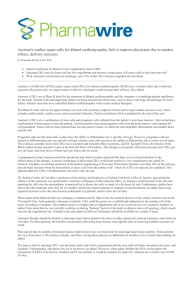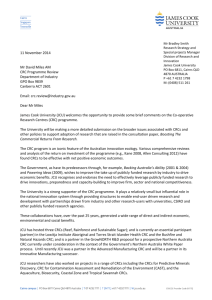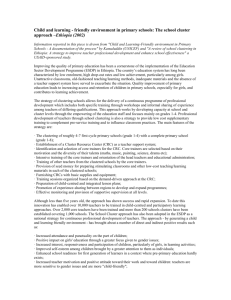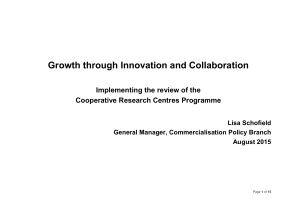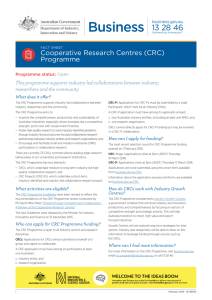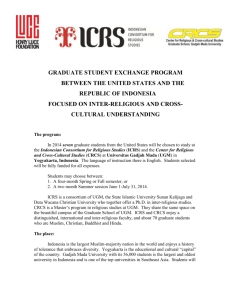Paper Title (use style: paper title) - digital
advertisement
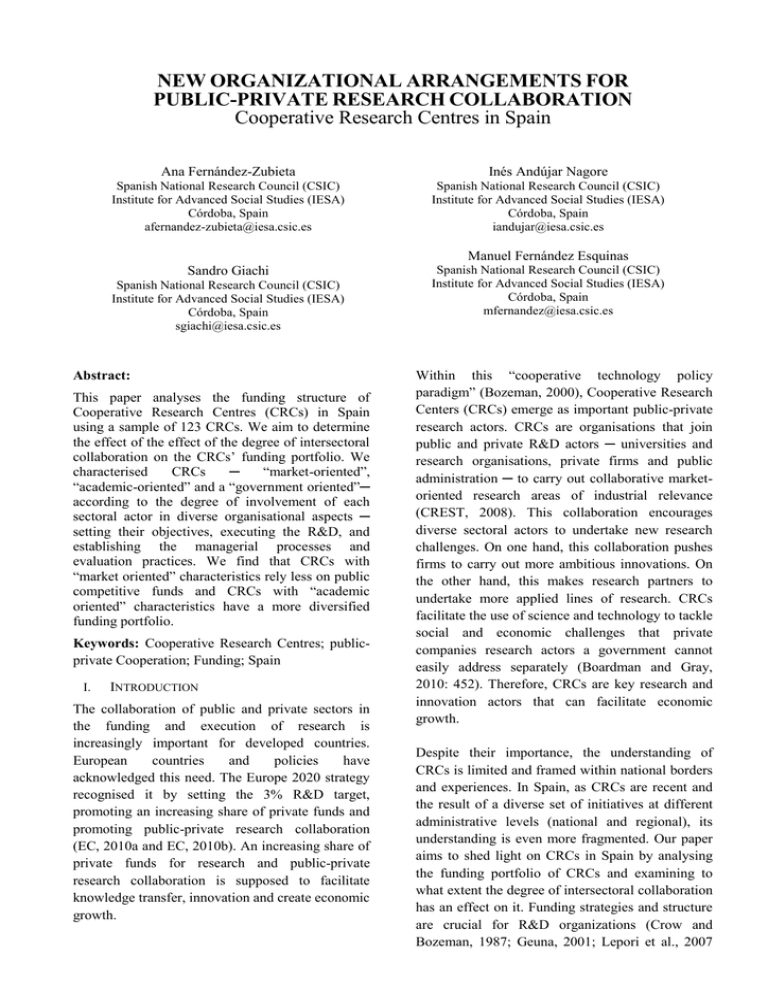
NEW ORGANIZATIONAL ARRANGEMENTS FOR PUBLIC-PRIVATE RESEARCH COLLABORATION Cooperative Research Centres in Spain Ana Fernández-Zubieta Inés Andújar Nagore Spanish National Research Council (CSIC) Institute for Advanced Social Studies (IESA) Córdoba, Spain afernandez-zubieta@iesa.csic.es Spanish National Research Council (CSIC) Institute for Advanced Social Studies (IESA) Córdoba, Spain iandujar@iesa.csic.es Sandro Giachi Spanish National Research Council (CSIC) Institute for Advanced Social Studies (IESA) Córdoba, Spain mfernandez@iesa.csic.es Manuel Fernández Esquinas Spanish National Research Council (CSIC) Institute for Advanced Social Studies (IESA) Córdoba, Spain sgiachi@iesa.csic.es Abstract: This paper analyses the funding structure of Cooperative Research Centres (CRCs) in Spain using a sample of 123 CRCs. We aim to determine the effect of the effect of the degree of intersectoral collaboration on the CRCs’ funding portfolio. We characterised CRCs ─ “market-oriented”, “academic-oriented” and a “government oriented”─ according to the degree of involvement of each sectoral actor in diverse organisational aspects ─ setting their objectives, executing the R&D, and establishing the managerial processes and evaluation practices. We find that CRCs with “market oriented” characteristics rely less on public competitive funds and CRCs with “academic oriented” characteristics have a more diversified funding portfolio. Keywords: Cooperative Research Centres; publicprivate Cooperation; Funding; Spain I. INTRODUCTION The collaboration of public and private sectors in the funding and execution of research is increasingly important for developed countries. European countries and policies have acknowledged this need. The Europe 2020 strategy recognised it by setting the 3% R&D target, promoting an increasing share of private funds and promoting public-private research collaboration (EC, 2010a and EC, 2010b). An increasing share of private funds for research and public-private research collaboration is supposed to facilitate knowledge transfer, innovation and create economic growth. Within this “cooperative technology policy paradigm” (Bozeman, 2000), Cooperative Research Centers (CRCs) emerge as important public-private research actors. CRCs are organisations that join public and private R&D actors ─ universities and research organisations, private firms and public administration ─ to carry out collaborative marketoriented research areas of industrial relevance (CREST, 2008). This collaboration encourages diverse sectoral actors to undertake new research challenges. On one hand, this collaboration pushes firms to carry out more ambitious innovations. On the other hand, this makes research partners to undertake more applied lines of research. CRCs facilitate the use of science and technology to tackle social and economic challenges that private companies research actors a government cannot easily address separately (Boardman and Gray, 2010: 452). Therefore, CRCs are key research and innovation actors that can facilitate economic growth. Despite their importance, the understanding of CRCs is limited and framed within national borders and experiences. In Spain, as CRCs are recent and the result of a diverse set of initiatives at different administrative levels (national and regional), its understanding is even more fragmented. Our paper aims to shed light on CRCs in Spain by analysing the funding portfolio of CRCs and examining to what extent the degree of intersectoral collaboration has an effect on it. Funding strategies and structure are crucial for R&D organizations (Crow and Bozeman, 1987; Geuna, 2001; Lepori et al., 2007 and Aghion et al., 2010). To this end, we characterise CRCs according to their degree of intersectoral collaboration ─“market-oriented”, “academic-oriented” and a “government oriented”─ and test if these have an effect on the CRCs funding structure. Using a database 123 CRCs, we specially focus on two funding sources ─ public competitive funds and funds from contracts and services to firms─ and consider other funding sources through an analysis of the diversity of CRCs’ funding sources. We find that CRCs with “market oriented” characteristics rely less on public competitive funds and that CRCs with “academic oriented” characteristics have a more diversified funding portfolio. This article is organised as follows: Section 2 introduces the theoretical background; Section 3 presents the hypotheses; Section 4 summarises the dataset, methodology and empirical strategy; Section 5 reports the results and Section 6 concludes. II. THEORETICAL BACKGROUND Current knowledge and innovation processes relies heavily on synergistic interactions among R&D actors and sectors ─ universities and research organizations, private companies and government. This trend entails to overcome the traditional frontiers between public and private sectors (Gibbons et al., 1994; Etzkowitz and Leydersdorff, 2000; Malerba, 2004). As a result, new social and organizational forces have emerged within current innovation systems as, for example, the collectivization of research, the emergence of a cooperative paradigm for research policy or the emphasis of open innovation strategies within industry (Boardman and Gray, 2010). In Spain, formal public-private research collaborations are also increasingly important within current innovation systems In this context, the so-called “Cooperative Research Centers” (CRCs) arise as especially relevant actors. They consist of centres that join different public and private R&D actors and carry out collaborative market-oriented research on areas of industrial relevance (CREST, 2008). This may, on one hand, encourage firms to undertake more radical kinds of innovation, and on the other, help universities to initiate and perform new and more applied lines of research. Therefore, CRCs enable the use of science and technology to address social and economic problems that academic units, government actors and private companies cannot easily face unilaterally (Boardman and Gray, 2010: 452). It seems, then, that in the current scenario of European crisis, CRCs appear as key actors for innovation and growth. CRCs are the result of national public policies and private initiatives. In United States, Australia and Canada, the emergence of CRCs began in the 1980s as a result of national policy program research on cooperative research. They have been evaluated by The Industry/University Cooperative Research Centers Program Evaluation Project (in the USA) and by the Industry and Innovation Studies Research Group (in Australia), and have been subject of extensive analysis (for example, Roessner, 2000; Gray et al. 2001; Gray, 2011; Garrett-Jones and Turpin, 2010; Turpin et al. 2005; Garrett-Jones et al. 2013 or Atkinson et al. 2001). In some European countries, like Austria, Norway, Sweden and, more recently, Ireland, similar policy programmes appeared in the 1990s and have been partially evaluated by consulting firms such as Circa Group and the Technopolis Group (Arnold et al., 2004). Although the understanding of CRCs is increasing, it is still limited and framed within national borders and experiences. In Spain, formal public-private collaborations are more recent (since 2000s) and are the result of diverse initiatives at different administrative levels ─ national and regional (Fernández-Esquinas and Ramos-Vielba, 2011). At national level, we can find formal agreements and/or consortia between public research organizations and companies ─ for example, “Pharmacia” laboratory at the CSIC, INIA, IRTA or FIAB ─ and new centres with public and private partners, generally foundations ─for example, CNIO. At regional level, we can find some programmes inspired by foreign experiences ─ for example, in the Basque Country (Olazaran et al., 2009) ─ new centres, generally foundations, ─ for example, the CTTO in Catalonia ─ and already existing centres that acquire new missions ─ for example, some Technological Centres (Callejón et al., 2007). It is relevant to study the Spanish CRCs as they are an increasing a diverse phenomenon. The study of CRCs in Spain is relevant as publicprivate research collaborations are becoming more important for current R&D systems and societies. It is crucial to understand the role of CRCs as new and diverse research actors. As R&D organisations, the understanding of CRCs requires to pay attention to their funding structure and strategy. A. Funding and organization of Cooperative Research Centres Funding structure and strategies are crucial for the development, performance and efficiency of R&D organizations. Crow and Bozeman (1987) show for a sample of public research laboratories that different sources of funding ─ public or private ─ lead to different research products (“generic products”- public goods vs. “appropriable products” for private use). Several studies on universities show that different funding mechanisms have evolved (Geuna, 2001; Bonaccorsi and Dario, 2007; Lepori, 2011) and are essential for the quality and effectiveness of their research. For example, Aghion et al. (2010) show for a sample of European universities that a funding portfolio highly based on competitive funds enhances their research productivity, given a certain level of autonomy. Different sources of funding (public-private) and coming through diverse funding mechanisms (competitive funds) are important for R&D organisations strategies and performance. The funding structure of CRCs is shaped by their “public-private” nature and the degree of governmental support. Direct public funds coming from the Cooperative Research Centers Program are central for Australian CRCs (Slatyer, 1994). However, more diversified and private source of funds characterise North American CRCs (Geisler et al. 1991). In Spain, there is evidence of a change in the funding structure of governmental laboratories and technology centres towards a more diversified and increased share of competitive public funds (Cruz-Castro et al., 2012). Due to their public-private nature, it is important to study the diversity of funding sources and funding strategies of CRCs. The main characteristics and challenges of CRCs come from their “hybrid” (public-private) nature. CRCs have to deal with the different expectations, goals and research interests of the agents involved, ranging from research excellence and economic returns (Roessner et al. 1998; Lee, 2001; Santoro and Chakrabarti, 2001; Feller et al., 2002; Carayol, 2003). CRCs have also to handle changes in the traditional roles of the different sectoral actors, including R&D execution. Universities and research centres have to share the execution of R&D with firms. Tornatzfy et al., (2002) or Boardman and Gray (2010) find that big and high technological company partners are important R&D executors. In addition, management and evaluation practices have to deal with the requirements of different sectoral-actors. For example, Turpin et al. (2005) and Turpin and Deville (2005) point out this need in organising the career tracks and incentives of researchers that work at CRCs centres (Turpin et al., 2005 and Turpin and Deville, 2005). The degree of involvement of each sectoral partner in different organisational aspects of CRC’s, such as, setting their objectives, executing the R&D, and establishing the managerial processes and evaluation practices, might determine the behaviour of CRCs. There is an increase demand for research organisations to have a more diversified funding portfolio, coming from public and private sources and through diverse funding mechanisms. Due to the “hybrid” nature (public-private) of CRCs, it appears to be more relevant to understand the funding structure of these new research organisations. In order to study the diverse sources of funding of CRCs, it is relevant to pay attention to the degree of involvement of different actors. The degree of involvement of each sectoral actor in the CRCs organisation could lead CRCs to rely more in a specific source of funds, which in turn could affect to their performance and their opportunities to adapt to a changing environment. Each paper should start with a short introduction stating the problem / knowledge gap addressed in the paper, the main goal of the paper as well as a short paragraph about the structure of the paper. Following this introduction, the main part of the paper should follow, e.g. literature review and empirical results or a detailed description of the approach in practitioner papers. Please structure the main part of your paper as it best suits your project. Both academic and practitioner papers should contain a section with the main results / findings followed by a discussion of these findings / results. Papers should end with a conclusion which might include a summary of the paper as well as its limitations, recommendations and suggestions for further research and action. The conclusion should be in harmony with the introduction. The full paper must be an understandable entity by someone that has not attended the session at the conference. III. HYPOTHESES In this article we want to test the following hypothesis regarding the effect of the degree of intersectoral collaboration on the funding structure of CRCs: H1. A higher participation of universities and research organisations in the organisation of CRCs leads to a higher share of funds coming from public competitive sources. Since public funds are increasingly allocated through competitive mechanisms, we expect universities and research organisations to be more able to collect this type of funds. Therefore, CRCs with these characteristics ─ academic oriented ─ will be more successful to get this type of sources. H2. A higher participation of the private sector in the organisation of CRCs leads to a higher share of funds coming from private sources. CRCs with these characteristics ─ market oriented ─ have more experience and are more able to collect private funds. H3. The degree of intersectoral collaboration has an effect on the diversity of funding sources. A higher participation of the private sector in the organisation of CRCs could lead to a higher diversification of CRC’s funding structure. The profitable character of private actors could lead “market oriented” CRCs to be more skilled to acquire funds from different sources. However, it could also negatively affect the diversity of funding sources as these skills to acquire funds could be more specific to acquire funds from the private sector leading “market oriented” CRCs to rely more importantly on private sources of funding. IV. MATERIAL AND METHODS A. Data and sample We use data coming from the research Project “Emerging Forms of Cross Sector Collaboration between Science and Industry: Cooperative Research Centres in the Spanish R&D System” (ES-CRCs) launched by IESA-CSIC in 2010. This is an on-going three years project that includes three surveys: to (1) cooperative research centres, (2) firms and (3) researchers involved in the centres. Here we report results on the first survey to CRCs. In order to obtain our final sample we identified the whole population of CRCs. Due to the diversity of Spanish public-private collaboration initiatives carried out at different administrative levels ─ national and regional ─, there is not a complete directory of Spanish CRCs. Therefore, we mapped the existing R&D collaborative arrangements in Spain through a systematic review of secondary sources of data and web search.i We operationalized the description of CRCs, following the definition of Boardman and Gray (2010), as organisation that explicitly recognise: To have a formal structure and a separate legal entity, To conduct R&D activities and To have least one public and one private actor among their partners. We reached a final population of CRCs in Spain of 163 centres. We sent the questionnaire using a postal/web mixed-mode technique (Diment & Garrett-Jones 2007) and telephone reminder using CATI system targeting to the directors of the centres or high-profile managers. On-line access to questionnaire has been opened from August to October 2012. We sent 6 e-mail and 3 postal remainders to the centres. We had a response rate of 75.46%, reaching a “strategic” sample of 123 CRCs. Table I shows the geographical distribution of the population and sample of these centres. We didn’t find a significant difference in the geographical distribution of CRCs between the population and our sample: all differences are inferior to 1-2%. Table 1: Geographical distribution of the population and sample of CRCs in Spain Region Andalucía Aragón Asturias Baleares Canarias Cantabria Castilla La Macha Castilla y León Cataluña Cdad. Valenciana Extremadura Galicia Madrid Murcia Navarra País Vasco Rioja (La) Total Population (n -%) 31 19 5 3.1 8 4.9 6 3.7 6 3.7 2 1.2 4 2.5 3 1.8 22 13.5 18 11 4 2.5 9 5.5 15 9.2 2 1.2 4 2.5 21 12.9 3 1.8 163 100 o B. Variables We use three independent variables CRC’s funding sources: (1) proportion of funds from public competitive calls and (2) proportion of funds from contracts and services to firms and (3) Shannon Diversity Index of funding sources. The two fist variables are the most important sources of funding in relative terms, representing the 63% of funds of CRCs.ii The Shannon Indexiii considers all funding sources and aims to analyse the diversity in the structure of the funding portfolio of each CRCs. If the majority of funds come from one source, and other sources are very rare, the index approaches to 0. o o o o A high participation of the firms and Research Centres on direct execution of R&D Firms are also important in the definition of CRC’s strategic plans Firms are also involved in the control and supervision of the CRC. Government is highly involved in the control and supervision of the CRC Government is highly involved in the definition of CRC’s strategic plans Firms are not involved in the direct execution of R&D “Academic Oriented” ─ Component 3─ is mainly characterised by: o o The central variables in our analysis aim to take into account the degree of intersectoral collaboration of CRCs. These are measured by the degree of involvement that each sectoral partner ─ Universities and research centres, government and firms ─ has in the CRC at three different organisational levels: setting the CRCs objectives; R&D execution and management and evaluation. We consider CRC responses to a set of nine 5-scale questionsiv ranging from “Not Important” to “Very important” on these issues. We obtain our final proxies for degree of intersectoral collaboration through a principal component analysis (PCA), v resulting in three variables with propensity scores for the three components: “Market Oriented” ─Component 1─ is mainly characterised by: 20.3 3.3 4.9 4.9 3.3 1.6 2.4 0.8 14.6 8.9 3.3 4.1 8.1 1.6 1.6 13.8 2,4 100 “Government Oriented” ─ Component 2 ─ is mainly characterised by: o Sample (n -%) 25 4 6 6 4 2 3 1 18 11 4 5 10 2 2 17 3 123 o Low involvement of firms in definition of CRC’s strategic plans High involvement of Research organisation in the direct execution of R&D Government have a role in the control and supervision of the CRC. Other important explanatory variables are R&D Activities, Sector, legal form, size, year and regional R&D intensity. Four different dummy variables consider the importance of diverse R&D Activities of CRCs ─ R&D Basic, R&D Applied, Technological development and Technological Services. These take the value of 1 when the CRC considers the activity as “very important” (the highest level of a 5-scale question). These four variables are included after checking that they are not highly correlated. Sector of economic activity is a categorical variable with three categories ─ Primary, Secondary and Tertiary. Legal form is a dummy variable that takes the value of 1 if the CRC is a Foundation and 0 otherwise. Size is proxied by the total number of personnel of the centre. Year of foundation is a dummy variable that takes the value of 1 if the CRC was founded in 2008 or afterwards. Region considers the R&D Intensity ─ Gross Expenditures on Research and Development (GERD) as a percentage of the Gross Domestic Product (GDP) ─ of the region in which the CRC is located for the year 2011 (last year available INE). A. Descriptive statistics Table 2 presents the summary of statistics. Our average CRC gets the 32% of their funds from public competitive calls, a 31% from contracts and services to firms. These are the main source of funds for CRCs. The average Shannon Diversity Index of funding sources is 0.87. Most part of CRCs recognises that Applied R&D activities are “very important”. Technological development and Technological services are also important activities with, respectively, a 44% of CRCs recognising that these activities as “very important”. Basic R&D Activities are less essential for CRCs with a 22% of them affirming that they are “very important”. Although the different variables on R&D Activities are not highly correlated, the importance of R&D Basic activities is negatively correlated to the importance of technological development and technological services. This is also the case for the degree of importance of R&D applied and technological services activities. This indicates that less applied research activities are difficult to combine with more technological oriented activities. Most part of CRCs is involved in the secondary sector of the economy with a 65% of centres reporting this sector as their main sector of economic performance. A 25% of CRCs are mainly involved in the tertiary sector of the economy, whereas a 10% do so in the primary sector. A 52% of CRCs are foundations. The average CRC has 136 workers. A 18% of the CRCs were founded after 2008. The average CRC is located in a region with a R&D Intensity of 1.28 in 2011, close to the Spanish average of 1.33. C. The model To explain our dependent variables ─ (1) proportion of public competitive funds, (2) proportion of funds coming from contract and services to firms and (3) Shannon diversity Index ─we use a two-limits Tobit model: where is a latent variable censored from above and below at the same time and a set of explanatory variables. YL is always ≥ 0. Yu ≤ 1 for dependent variables (1) and (2) and Yu≤ 1.6 for our last dependent variable (3). V. RESULTS AND DISCUSSION In this section we present the results of the descriptive and econometric analysis based on the two-limit Tobit model Table 2: Summary statistics Variable Funds from public competitive calls Funds from contracts and services to firms Shannon Diversity Index of funding sources R&D Activity R&D Basic R&D Applied Technological development Technological Services Sectors Primary Secondary Tertiary Legal Form (Foundation) Size (personnel) Year Foundation Region (R&D Intensity) Obs. 107 107 107 Mean 0.32 0.31 0.87 Std. Dev. 0.23 0.26 0.33 Min 104 104 105 105 0.22 0.53 0.44 0.44 0.42 0.50 0.50 0.50 0 0 0 0 1 1 1 1 103 103 103 123 79 123 123 0.10 0.65 0.25 0.52 136.34 0.18 1.28 0.30 0.48 0.44 0.50 337.80 0.38 0.51 0 0 0 0 1 0 0.36 1 1 1 1 2628 1 2.07 0 0 0 Max 0.99 0.95 1.50 B. Multivariate analysis Table 3 presents results of the econometric analysis from the two-limit Tobit regression (Long, 1997).vi We report seven sets of results from the analysis of three dependent variables: (1) Proportion of Funds from public competitive calls, (2) Proportion of funds from contracts and services to firms and (3) Shannon’s Diversity Index of funding sources. First three columns show results of different specifications of a regression of the proportion of funds from public competitive calls on our main independent variables ─ type of CRC defined by the degree of involvement of different sectoral partners ─ (i), adding R&D activity and economic sector controls (ii) and other institutional and regional controls (iii). We present similar specifications for the analysis of the proportion of funds coming from contracts and services to firms (iv-vi). Finally, the last column (vii) provides results of the regression of the Shannon’s Diversity Index of funding sources on our main independent variables controlling for the rest of variables. The results of the first specification (i) show that the coefficient of “market oriented” CRCs is negative and significant. The effect is on the uncensored latent variable, not on the observed outcome (McDonald and Moffit, 1980). The coefficients for “academic oriented” and “government oriented” CRCs are positive but not significant. This indicates that CRCs with “market oriented” characteristics rely less on funds coming from competitive calls. Specification (ii) confirms the negative effect of “market oriented” CRCs on the proportion of funds coming from competitive public calls when including controls for R&D activity and economic sector activity. The coefficient for this type of CRC increases significance compared to previous specification. Regarding R&D activities, the coefficients for basic and technological services activities are positive and significant. This indicates that CRCs for which basic and technological services are very important have a higher proportion of funds coming from public competitive calls. This could indicate that there is not a crowding-out effect of basic and technological services activities or that CRCs are specialised in one of this two activities. The coefficients for tertiary sector are negative and highly significant (1%), pointing that CRCs that concentrate their activities in the tertiary sector of the economy have a lower proportion of funds coming from public competitive calls when compared to CRCs whose main activity are in the secondary sector of the economy. This shows that CRCs with market oriented characteristics whose main activities are in the tertiary sector of the economy do not tend to have a high proportion of funds coming from public competitive funds whereas CRCs for which basic and technological R&D activities are very important do rely more importantly in this source of funds. Specification (iii) confirms the negative effect of “market oriented” characteristics on the proportion of funds coming from competitive calls when including all the controls. However, the coefficients for basic R&D activity and tertiary sector are not significant when including controls for the legal form, size, year of foundation of the CRCs and R&D Intensity of the region in which the CRC is located. The coefficients for “year of foundation” and “R&D intensity” are positive and significant at 10% level of significance. This indicates that CRCs that were funded after 2008 were more able to collect a high proportion of funds from competitive public calls. It appears that CRCs located in regions with high R&D intensity rely more heavily on public competitive calls. Our first hypothesis is not confirmed as coefficients for “academic oriented” are not significant, but we see that the CRC characteristics affect the ability to acquire this source of funds, negatively for “market oriented” characteristics. In summary, CRCs with “market oriented” characteristics rely less in funds coming from public competitive calls whereas young CRCs that provide technological services, located in regions with high R&D intensity do rely more on this source of funds. Considering the three specifications of the proportion of funds coming from contracts and services to firms, we can see in the first specification (iv) that the effect of “academic oriented” is negative and significant at 5% level. This indicates that CRCs with academic oriented characteristics rely less on funds coming from contracts and services to firms. The coefficients for “market oriented” CRCs are positive whereas the coefficient for “government oriented” is negative, but both coefficients are not significant. The coefficient for “academic oriented” CRCs is also negative and significant when including controls for R&D Activity and economic sector (v). However, this coefficient becomes non-significant in the last specification (vi) when all the controls are included. The coefficient for “basic R&D activity” is negative and significant across specifications. This points that CRCs for which basic R&D activities are very important tend to rely less on funds coming from contracts and services to firms. The coefficient of “year of foundation” is negative and significant, indicating that CRCs founded after 2008 proportionally rely less on funds coming from contracts and services to firms. This could also indicate that CRCs founded during the crisis had more difficulties for getting funds from contracts and services to firms. It appears that “academic oriented” CRCs rely in a lower proportion on contracts and services to firms, but other factors, such as, basic R&D activities and year of foundation are more determinant than the type of CRC when explaining the proportion of funds coming from contracts and services to firms. The results of the regression on the Shannon’s Diversity Index (vii) show that the coefficient for “academic oriented” is positive and significant, indicating that CRCs with academic oriented characteristics have a more diversified source of funds. This confirms our third hypothesis that CRC characteristics have an effect on the degree of diversity of funding sources. The coefficient for “market oriented” is also positive but not significant. The coefficient for “government oriented” is negative but also not significant. Then, we cannot say that CRCs with these characteristics affect to the diversity of funding portfolio. Considering R&D activities, the coefficients for “basic” and “technological development” are negative and significant. This indicates that CRCs for which these activities are very important have a less diversified funding portfolio. This could indicate that “less applied” research and technology activities have more difficulties to acquire funds from different sources. It appears that these types of activities are more dependent of a specific source of funds. This could be due the intrinsic characteristics of the R&D activity or due to the lack of “abilities” of the personnel of the CRCs specialised in this R&D activities to acquire funds from different sources. The coefficient of “tertiary sector” is negative and significant indicating that CRCs whose main economic activity is in the tertiary sector have a less diversified funding portfolio compared to CRCs operating in the secondary sector of the economy. The coefficients for legal form, size, year of foundation and region are not significant. In summary, the orientation of the CRCs has an effect on the diversity of the funding portfolio and that “less applied” research and technologies and tertiary activities reduce the diversity of the funding portfolio. The p-values of likelihood ratio chi-square tell us that our model fits significantly better than an empty model. Sigmas values are lower than standard deviation of the first (0.234), second (0.310) and third (0.328) dependent variable (for 106 sample). The predicted values share about 45% and 50% of their variance with first and third dependent variable. Table 3. Results from the Tobit (two limits) model Proportion Funds from public competitive calls (i) (ii) (iii) Proportion Funds from “contracts and services to firms (iv) (v) (vi) Shannon's Diversity Index (vii) Type CIC (mix model) Market Oriented Government Oriented Academic Oriented -0.0319* (0.017) 0.00143 (0.023) 0.0402 (0.025) -0.0607*** (0.018) -0.00363 (0.021) 0.0356 (0.025) -0.0728*** (0.020) -0.01 (0.022) 0.02 (0.030) 0.145* (0.081) -0.0485 (0.055) 0.045 (0.053) 0.171*** (0.060) 0.137 (0.090) -0.167*** (0.061) 0.00365 (0.020) -0.0176 (0.027) -0.0770** (0.029) 0.0194 (0.021) -0.0181 (0.025) -0.0566* (0.030) 0.00833 (0.025) 0.0158 (0.027) -0.0135 (0.038) 0.0409 (0.027) -0.0416 (0.030) 0.0930** (0.041) -0.02 (0.091) 0.01 (0.062) 0.10 (0.065) 0.150** (0.069) -0.261** (0.098) -0.0203 (0.066) 0.0917 (0.065) -0.0367 (0.073) -0.254** (0.114) -0.0827 (0.078) -0.018 (0.081) 0.0111 (0.087) -0.444*** (0.124) -0.0248 (0.085) -0.198** (0.088) 0.135 (0.095) 0.08 (0.091) -0.10 (0.077) -0.169 (0.109) -0.0501 (0.073) -0.107 (0.114) -0.121 (0.096) -0.0493 (0.125) -0.357*** (0.105) R&D Activity RD_Basic5 RD_Applied5 TechDevelopment5 TechServices5 Sector (Secondary) Primary Tertiary Legal form Foundation -0.03 (0.056) 0.0533 (0.070) 0.0543 (0.077) Total Personnel 0.00 (0.000) 0.000734 (0.000) -0.000418 (0.000) 2008 0.152* (0.080) -0.193* (0.100) 0.102 (0.109) R&D intensity 0.357*** (0.030) 0.415*** (0.064) -0.0624 (0.095) 0.541*** (0.162) 0.134 (0.104) 0.887*** (0.177) 0.230*** (0.021) 58 6.97* 0.209*** (0.020) 55 17.37** 0.190*** (0.021) 41 22.03** 0.208*** (0.023) 41 28.85*** Size Year foundation Region Constant 0.297*** (0.026) 0.224*** (0.053) 0.139* (0.076) 0.06 (0.129) Sigma 0.197*** (0.018) 58 5.65 0.173*** (0.017) 55 22.1*** 0.152*** (0.017) 41 24.43** N likelihood ratio chi-square VI. CONCLUSIONS AND RECOMMENDATIONS This paper analysed public-private collaborative agreements in Spain. Due to their public-private nature, Cooperative Research Centres are becoming relevant actors in the R&D research systems. We addressed the analysis of the funding structure of CRCs considering the degree of intersectoral collaboration and controlling for other aspects. We characterised CRCs ─ “market-oriented”, “academicoriented” and a “government oriented”─ according to the degree of involvement of each sectoral actor in diverse organisational aspects ─ setting their objectives, executing the R&D, and establishing the managerial processes and evaluation practices. We focused on the effect of these characteristics of CRCs on the public ─ public competitive funds ─ and private ─ contracts and services to firms ─ nature of its funding sources, as well as, on the diversity of all funding sources. The analysis of the proportion of competitive public funds showed that CRCs with “market oriented” characteristics rely less on this funding source. This funding source was also less common for CRCs whose main activities are in the tertiary sector. However, young CRCs that provide technological services, located in regions with high R&D intensity relied more on this source of funds. The analysis of the proportion of funds coming from contracts and services to firms provided some evidence that indicates that CRCs with “academic oriented” characteristics rely less on this funding source. However, other factors, such as, basic R&D activities and year of foundation were more determinant than the type of CRC when explaining the proportion of funds coming from contracts and services. CRCs for which basic R&D activities are very important rely less on this funding. This was also the case of young CRCs that started their activity during the economic crisis. Regarding the diversity of sources of funding of CRCs, we found that the orientation of CRCs has an effect on the diversity of the funding portfolio, being CRCs with “academic oriented” characteristics the ones with a higher diversity of funding sources. The increasing proportion of research funds allocated through competitive funds appears to have encouraged academic researchers and managers making them more able to acquire funds from different funding sources. CRCs focused on “less applied” research and technology activities, as well as the ones that focus on the tertiary sector of the economy, showed a lower diversity of their funding portfolio. These results showed that the degree of intersectoral collaboration of sectoral actors in the CRCs’ organisation have an effect of the funding structure of CRC. Particularly, we found that CRCs with “market oriented” characteristics rely less on public competitive funds and CRCs with “academic oriented” characteristics have a more diversified funding portfolio. This indicates that the involvement of each sectoral partner in the CRC affect their ability to acquire funds and their behaviour. i These include: (1) R&D and innovation public programs and plans, both at the national and regional level; (2) institutional web directories of R&D organizations, both at the national and regional level and (3) the webpages of the research centres with on-going R&D collaborative agreements. ii Funding sources are distributed as follows: “direct public funds” represents the 32% of the funds of CRCs; “Contracts and services to firms” follow with a 31%; “direct public funds” account for a 24.1%; “Membership fees”, “public contracts and services” and “Intellectual Property Rights” are minor funding sources with 6.3%, 5.1% and 0.3% respectively. “Other” funding sources account for 1.2% of the funds. iii The Shannon Index was originally an indicator of biodiversity in ecological systems, but now is frequently used to measure diversity in categorical data. The index is calculated by summing the products of each funding sources’ (or species) I share p with the natural logarithm of the same share and multiplying by -1. (S= -Σpilnpi) iv The questionnaire included a set of 12 questions. To avoid a problem of independence we have excluded three questions that covered funding issues. v Principal component is done considering six of these variables. Variables like the one that captures degree of involvement of government in R&D execution were not taken into account as results showed that the degree of involvement of this agent in this activity was not important. vi We have also considered a general linear model (Papke and Wooldridge, 1996) with a logit link and the binomial family to have also predicted values between zero and one. We include the robust option to obtain robust standard errors. However, as values of 0 and 1 or close to these figures are relevant answers, we have opted for a two-limit Tobit model in order to take into account this. Two models lead to similar results. Acknowledgements: We wish to thank Juan Antonio Dominguez for his skilful contribution in the implementation of the online questionnaire. Any errors are our own. A. References Aghion, P., M. Dewatripont, C. Hoxby, A. Mas-Colell and A. Sapir (2010) 'The governance and performance of universities: evidence from Europe and the US.' Economic Policy, 25 (61), 7-59 Arnold, E. Deuten, J. and van Giessel, J.F. (2004) An international review of Competence Centre Programmes. Brighton: Technopolis Group Atkinson-Grosjean, J., D.House and D. Fisher, (2001) 'Canadian Science Policy and Public Research Organizations in the 20th Century.' Science Studies, 14 (1), 3-25 Boardman, C. and D. Gray (2010) 'The new science and engineering management: cooperative research centres as government policies, industry strategies and organizations.' Journal of Technology Transfer, 35, 445-459 Bonaccorsi, A. (2008) 'Search regimes and the industrial dynamics of Science.' Minerva, 46, 285-315 Bonaccorsi, A. and Dario, C. (2007) Universities and Strategic Knowledge Creation. Specialisation and performance in Europe. Cheltenham: Edward Elgar Callejón, M. R., A. Barge, and A. López (2007) 'La cooperación público-privada en la innovación a través de los centros tecnológicos.' Economía Industrial, 366, 123-132 Carayol, N. (2003) 'Objectives, agreements and matching in science-industry collaborations: reassembling the pieces of the puzzle.' Research Policy, 32, 887-908 CREST (2008) Industry led competence centres. Aligning academic/public research with enterprise and industry needs (Report of the CREST working group). OMC Action Plan Crow, M. and B. Bozeman (1987) 'R&D laboratory classification and public policy: The effects of environmental context on laboratory behaviour.' Research Policy, 16 (5), 229-258 Cruz-Castro, L., L. Sanz-Menéndez and C. Martínez (2012) 'Research centers in transition: patterns of convergence and diversity Research centers in transition: patterns of convergence and diversity.' Journal of Technology Transfer, 37 (1), 18-42 Diment, K. & Garrett-Jones, S. (2007) 'How demographic characteristics affect mode preference in a postal/web mixed-mode survey of Australian researchers.' Social Science Computer Review, 25 (3), 410-417, European Commission (2010a) Europe 2020. A European strategy for smart, sustainable and inclusive growth. Luxembourg: Publications Office of the European Union European Commission (2010b) Europe 2020 Flagship Initiative Innovation Union. SEC(2010) 1161. Luxembourg: Publications Office of the European Union Etzkowitz, H. and L. Leydesdorff (2000) 'The dynamics of innovation: from National Systems and ‘‘Mode 2’’ to a Triple Helix of university–industry– government relations.' Research Policy, 29, 109123 Feller, I., C.P. Alies y J.D. Roessner (2002) 'Impacts of research universities on technological innovation in industry: evidence from engineering research centres.' Research Policy, 31, 457-474 Fernández-Esquinas, M. and Ramos-Vielba, I. (2011) 'Emerging forms of cross-sector research collaboration in the Spanish innovation system.' Science and Public Policy, 38 (2), 38-51 Garrett-Jones, S., T. Turpin and K. Diment (2013) 'Careers and Organisational Objectives: Managing Competing Interests in Cooperative Research Centres.' In: Cooperative Research Centers and Technical Innovation. Government Policies, Industry Strategies, and Organizational Dynamics. ed. by Boardman, G., Gray D.O. and Rivers D. Springer: 79-110 Garrett-Jones, S. and T. Turpin (2010) 'Reward, risk and response in Australian cooperative research centres.' International Journal of Technology Transfer and Commercialisation, 9 (1/2), 77-93 Geisler, E., A.Furino and T.J. Kiresuk (1991) 'Toward a conceptual model of cooperative research: Patterns of development and success in university-industry alliances.' IEEE Transactions on Engineering Management, 38 (2), 136-145 Geuna, A. (2001) 'The changing rationale for European university research funding: Are there negative unintended consequences?' Journal of Economic Issues, XXXV (3), 607-631 Gibbons, M., C. Limoges, H. Notwotny, S. Schwartzman y P. Scott (1994) The New Production of Knowledge. London: Sage Gray, D. O., Lindblad, M. and J. Rudolph (2001) 'Industryuniversity research centres: a multivariate analysis of member retention.' Journal of Technology Transfer, 26, 247-254 Gray, D.O. (2011) 'Cross-sector research collaboration in the USA: A national innovation systems perspective.' Science and Public Policy, 38, 123–133 Lee, Y. S. (2000) 'The sustainbility of University-Industry research collaboration: An empirical assessment.' Journal of Technonology Transfer, 25, 111-133 Lepori, B. (2011) 'Coordination modes in public funding systems.' Research Policy, 40, 355-367 Lepori, B., P. Besselaar, M. Dinges, B. Potì, E. Reale, S. Slipersæter, J. Thèves and B. Meulen (2007) 'Comparing the evolution of national research policies: what patterns of change?' Science and Public Policy, 34 (6), 372–388 Long S.L., (1997) Regression Models for Categorical and Limited Dependent Variables. Advanced Quantitative Techniques in the Social Sciences Number 7. Thousand Oaks, CA: Sage Publications Malerba, F. (2002) 'Sectoral Systems of Innovation and Production. ' Research Policy, 31, 247-264 McDonald, J.R. and Moffit, R. A. (1980) The uses of Tobit analysis. Review of Economics and Statistics, 62: 318-21. Olazarán M., Albizu E. and B. Otero (2009) 'Technology Transfer between Technology Centres and SMEs: Evidence from the Basque Country.' European Planning Studies, 17, 3-23 Papke, L. E & Wooldridge, J. M, (1996) 'Econometric Methods for Fractional Response Variables with an Application to 401(K) Plan Participation Rates.' Journal of Applied Econometrics, 11 (6), 619-32 Roessner, D. (2000) Outcomes and impacts of the State/Industry- University Cooperative Research Centres (S/IUCRC) Program.Final Report. SRI International Roessner, D. C.P. Ailes, I. Fellerandy and L. Parker (1998) How industry benefits from NSF’s Engineering Research Centres. Industrial Research Institute Santoro, M. D. and A.K. Chakrabartori (2001) 'Corporate strategic objectives for establishing relationships with University Research Centres.' IEEE Transactions of Engineering Management, 48 (2), 157-163 Slatyer, R.O. (1994) 'Cooperative research centres: The concept and its implementation.' Higher Education, 28 (1), 147-158 Tornatzfy, l.G., P.G. Waugaman and D.O. Gray (2002) Industry-University technology transfer: Models of alternative practice, policy and program. A benchmarking. Report of the Southern Growth Policies Board Turpin, T. and A. Deville (2005) 'Occupational roles and expectations of research scientists and research managers in scientific research institutions.' R&D Management, 25(2), 141-157 Turpin, T., Garret-Jones, S. and Diment, K. (2005) 'Scientists, Career Choices and Organisational Change: Managing Human Resources in Cross-sector R&D Organisations.' JANZAM, 11 (2), 13-26
